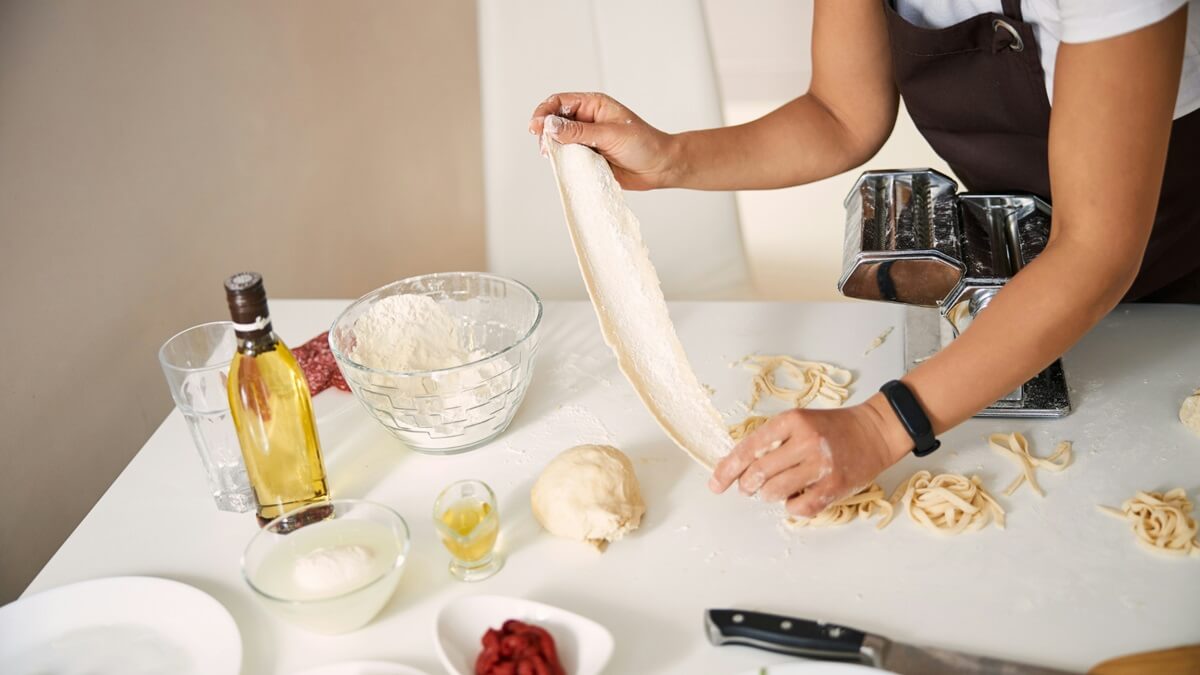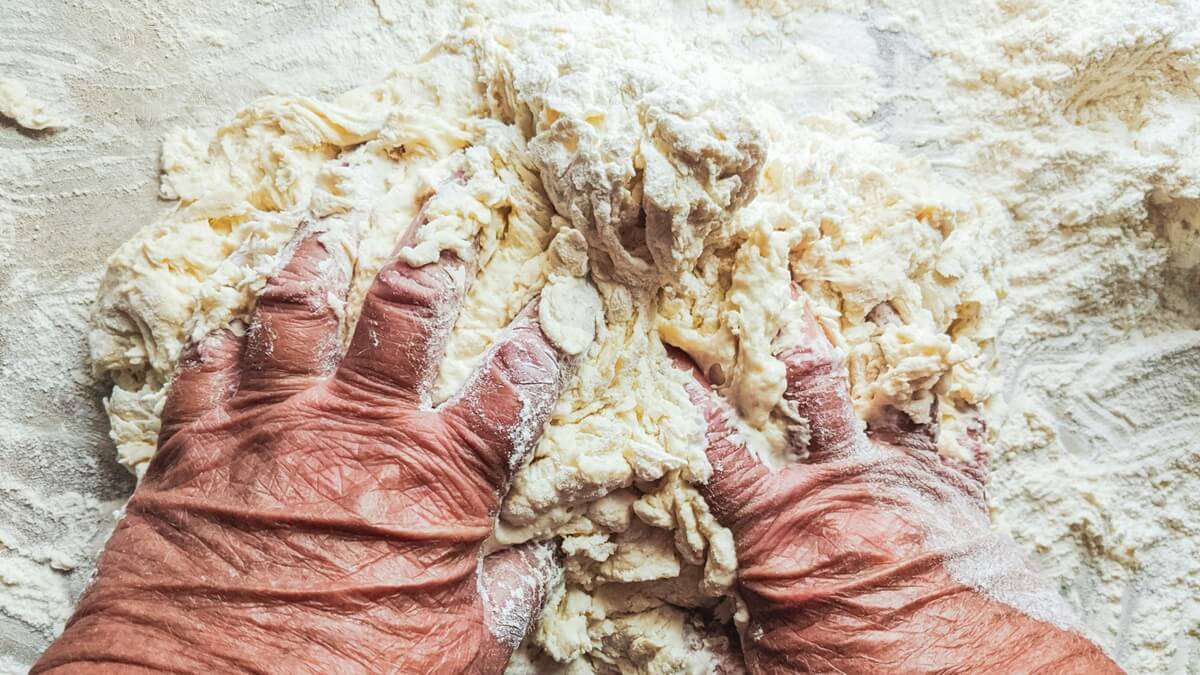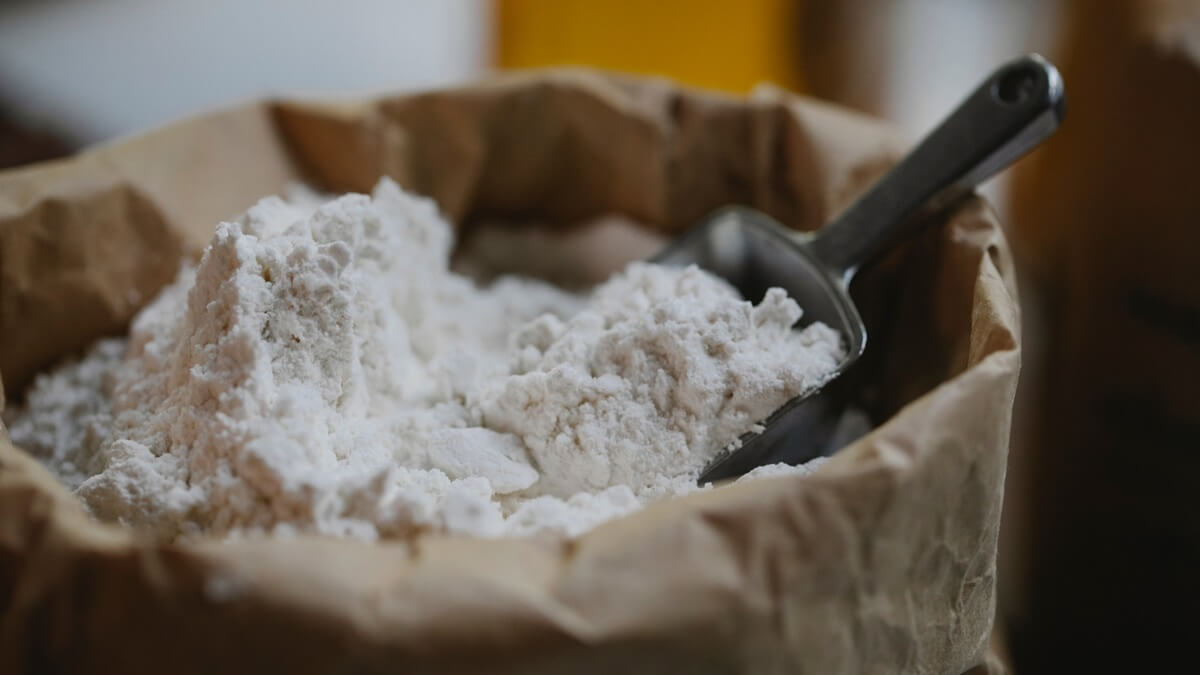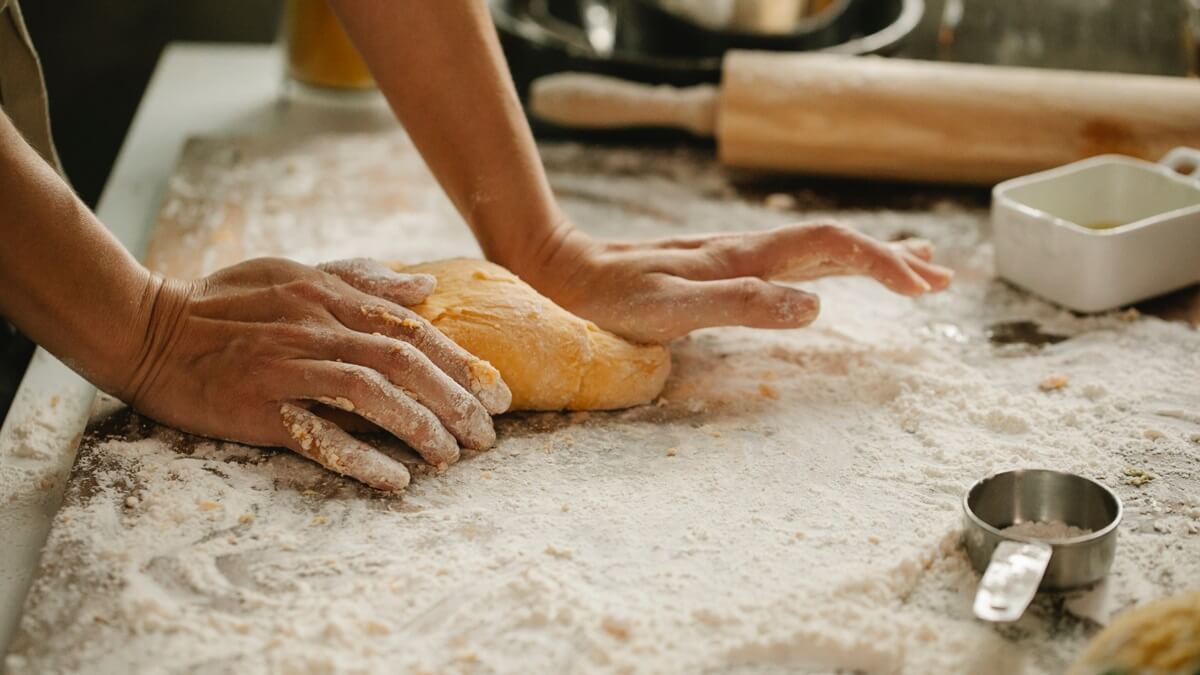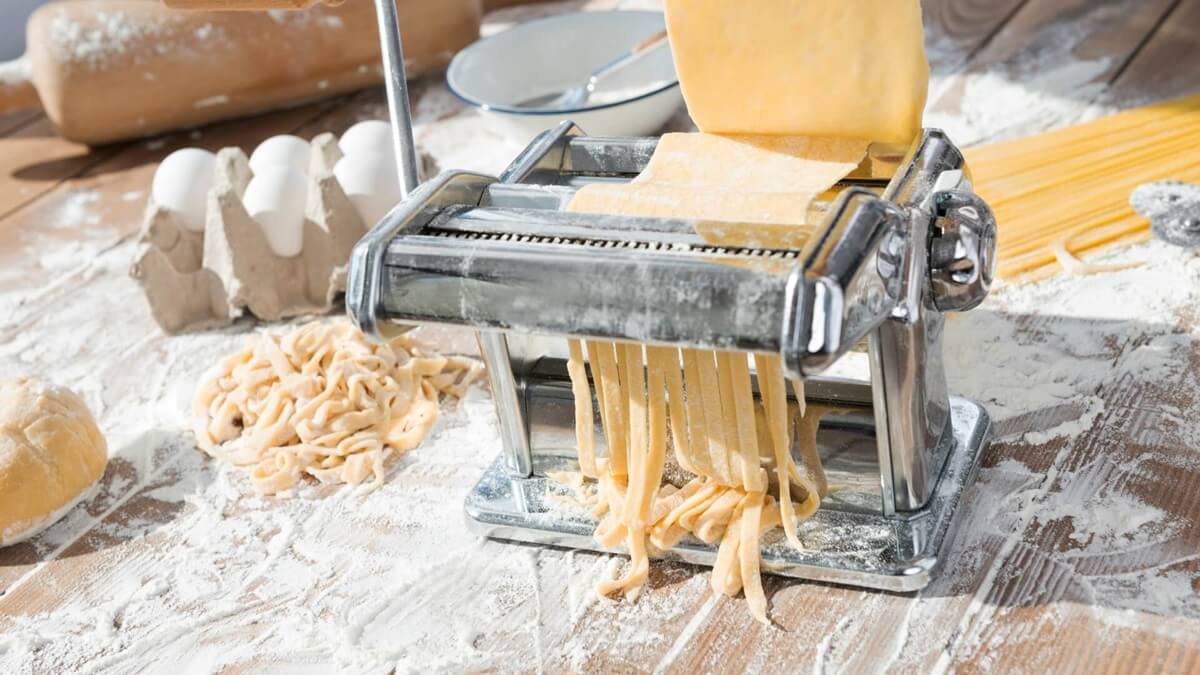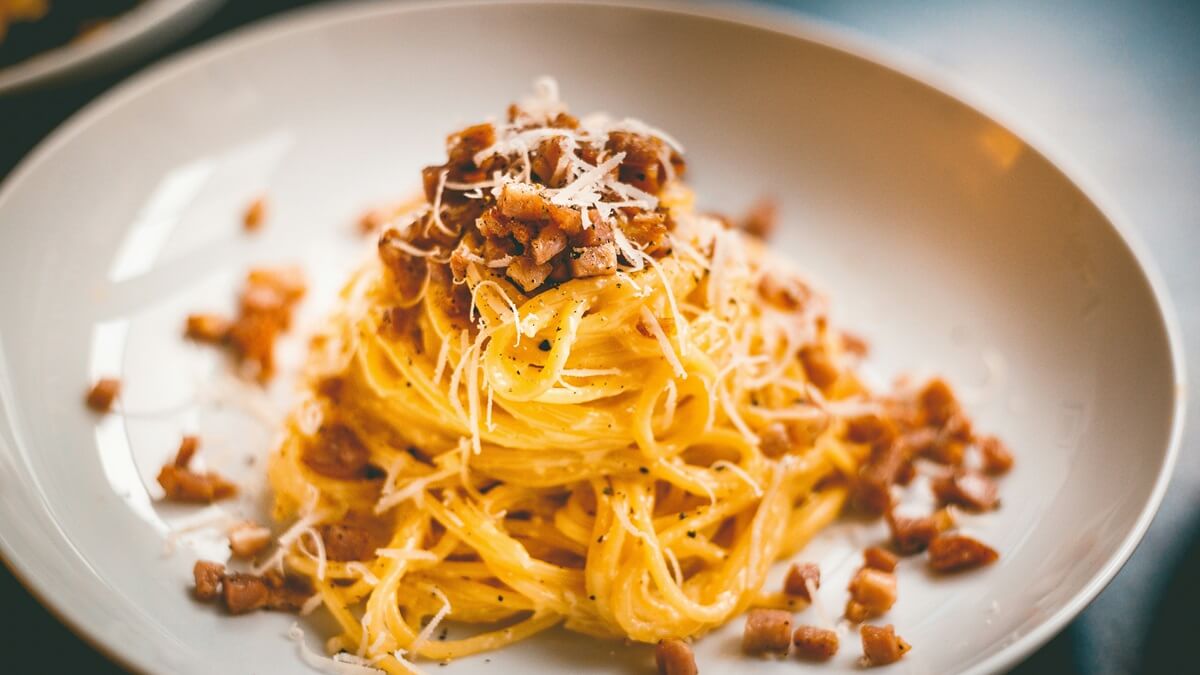Making fresh pasta at home may seem like a unique skill reserved only for lovable nonnas and expert chefs, but this couldn’t be further from the truth. Homemade Italian pasta is as simple to make as it is delicious, and all you need is a few high-quality ingredients and some practice.
Whether you’re a professional chef or a cooking novice, it’s never the wrong time to learn how to make authentic Italian fresh pasta from scratch.
Today, we’ll share our closely-guarded secrets to making silky-smooth authentic Italian pasta dough that will transport you to a traditional osteria and inspire visions of Roman hills and Mount Vesuvius’ smoking peak.
Roll up your sleeves and flour your surfaces, it’s time to make pasta!
The Basics of Making Italian Pasta
Before delving into the specifics of the art of making pasta, it’s important to understand a few basic principles of pasta making. While pasta dough is simple enough to make, there are a few key ideas to bear in mind.
Follow our professional pasta-makers’ tricks to make delicious, authentic Italian fresh pasta every time!
Essential Ingredients for Italian Fresh Pasta
One aspect of Italian food that makes it so world-famous is its local produce, sustainability and freshness. Of course, before you can start crafting your pasta dough and cooking your authentic Italian pasta recipe, you must gather your ingredients.
Which pasta dough ingredients you use will make a world of difference in how your pasta turns out, including its texture, color, consistency and taste.
Let’s delve into which ingredients you need to make traditional pasta dough and why.
White flour: You can’t make pasta dough without flour! While you can make whole wheat pasta at home using brown flour, we always recommend beginners use basic white wheat flour as it’s less finicky and will give you that classic authentic Italian taste. We’ll explore which white flour to use in the next section.
Semolina flour: This coarsely ground wheat flour is the key to your pasta’s grainy flavor and stretchy texture. Higher in protein, semolina flour not only boosts the pasta’s nutritional value but also allows it to be easily kneaded and come together into a cohesive dough. While semolina flour may be slightly harder to find outside of Italy, it’s an absolute must for anyone wanting to recreate traditional Italian pasta dough at home.
Eggs: Depending on which Italian region you’re drawing inspiration from during your pasta-making evening, your dough may include fresh eggs. Eggs add essential fats and proteins to the dough, which helps develop the gluten. This fat also smooths out the dough, making it pliable and soft. Not to mention, the orange egg yolks impart that golden hue we all know and love.
Salt: Last, but certainly not least, you’ll need a generous pinch of salt. Finer salt varieties, like sea salt or table salt, works best for authentic Italian pasta dough as it imparts that subtle salty flavor without affecting the texture.
The Importance of Using Quality Flour
If you’ve ever ventured into the flour aisle in an Italian grocery store, you’ve definitely seen the wide array of flours they have to offer. Unlike North American grocery stores which usually carry all-purpose, cake and whole wheat flour, Italian supermarkets categorize flour by the fineness of the ground.
While all-purpose flour can work for pasta dough, we highly suggest following Italians’ lead and using 00 flour instead.
This special, high quality flour is perfect for creating the ultimate Italian pasta dough thanks to its following characteristics:
Gluten content: Many gluten-sensitive people who come to Italy and can freely enjoy pasta and pizza without encountering their usual stomach problems often assume that Italian flours have a lower gluten content. However, this is opposite from the truth. 00 flour actually has a slightly higher gluten content (at around 12%) than all-purpose flour, lending it that stretchy but strong consistency.
Ground: If you were to feel the consistency between all purpose flour and 00 flour, the first thing you’d notice is the difference in texture. While all purpose flour is fine enough to be seamlessly mixed into baked goods, it is slightly coarser and if you pay close attention to the grain, you’ll be able to feel the individual particles of wheat. Meanwhile, 00 flour is ground so finely it’s almost powder-like. This contributes to its stretchability and smoothness, allowing you to make silky smooth pasta dough.
What type: Not all wheats are created equal and the type of wheat flour is milled from will drastically affect your final product. All purpose flour is made of ground red wheat while 00 flour is milled from durum wheat. Red wheat creates a highly elastic dough which springs back when stretched, making it prone to tearing. However, durum wheat is just as strong as red wheat while being less elastic, making it more pliable. This flexibility is key as it allows you to roll your pasta dough into long, uniform sheets.
Eggs or No Eggs? Regional Variations
Italy’s pasta is as diverse as its people and whether or not your pasta dough includes eggs depends on which part of Italy you’re drawing inspiration from.
Fresh pasta dough from Northern Italy usually has eggs in it to hold the dough together as 00 durum wheat flour (native to the region) is too fine to make into a dough simply with water.
Down in Southern Italy, pasta is primarily made from coarse semolina flour, native to the south. Combining this high-gluten flour with water is sufficient to activate the proteins, creating a stable and stretchy dough – no eggs needed!
How to Make Italian Pasta at Home: Step-by-Step Guide
Now that you’re familiar with the basic pasta ingredients, how your flour choice will affect the final outcome and which regions use eggs in their fresh pasta dough, it’s time to finally make authentic pasta dough at home!
Step 1: Prepare the Dough
Mix together 250 grams (2 cups and 1 tbsp) of 00 flour, the same amount of semolina flour and a couple of pinches of salt. Once combined, form your flour mixture into a mound on a clean, dry work surface. Use your finger to form a well in the center.
Add 5 tbsp of olive oil and 5 eggs to the well and use your finger to break the yolks and slowly incorporate more flour into the eggs.
Step 2: Knead and Rest the Dough
Once the dough has started to come together, it’s time to get kneading! Fold the dough on top of itself, until it’s smooth and uniform. Then, cover your dough with saran wrap and set it aside to rest at room temperature for half an hour.
Resting the dough is a crucial part of this process as it allows the gluten to relax, creating the perfect texture.
Step 3: Roll Out the Dough
Once the dough has rested, you can roll it out into those iconic long pasta sheets. If you have a pasta maker, run your dough through it on the widest setting. Gradually set your pasta maker to thinner settings until you reach the desired thickness. Do not fold your pasta dough in between running it through the pasta maker.
Don’t worry if you don’t have a pasta maker at home! You can still make authentic Italian pasta using only a rolling pin! On a floured surface, slowly roll out the pasta dough as uniformly as possible until it’s about ⅛ -inch thick.
Step 4: Cut the Pasta
Part of what makes pasta so fun to make is playing with different shapes, lengths and textures!
Using a pasta maker or sharp paring knife, slice the pasta into thin strips to make wonderfully silky tagliatelle.
Slices your sheets ino thick rectangles to make lasagna that, when paired with ragù, will blow your mind.
Use a pastry cutter wheel to cut small rectangles from your dough sheet. Pinch each rectangle in the center to create fun farfalle (i.e. bowtie) pasta.
If your pasta maker has different attachments, you can even make rigatoni or penne!
Step 5: Cook the Pasta
Your pasta has been kneaded, rested, rolled out and cut, and you couldn’t be more proud. Thankfully, the last step is also the easiest – cooking it!
Bring a pot of water to a roaring boil and salt generously. Carefully drop your fresh pasta into the boiling water and gently stir to prevent sticking.
Boil your pasta for 2 to 3 minutes before draining and adding it to your sauce.
And presto! Your pasta is ready and looking absolutely delicious.
Check out our article How to Cook Pasta the Italian Way: Authentic Techniques and Tips for a detailed guide to making traditional Italian pasta, including our insider tips on how to boil your pasta and authentic sauce pairings for different types of pasta.
Wrapping Things Up
Just like that, you’re a pasta pro!
Pasta requires the three Ps: patience, practice and, of course, prosecco as a treat throughout the long process. So, pour yourself a glass, sprinkle your counter with flour and get to work!
If you’re a fan of having a sweet treat after your traditional Italian pasta dinner, book our Hands-on Pasta Making and Tiramisù Class to learn how to make the ultimate Italian meal for your next dinner party.


